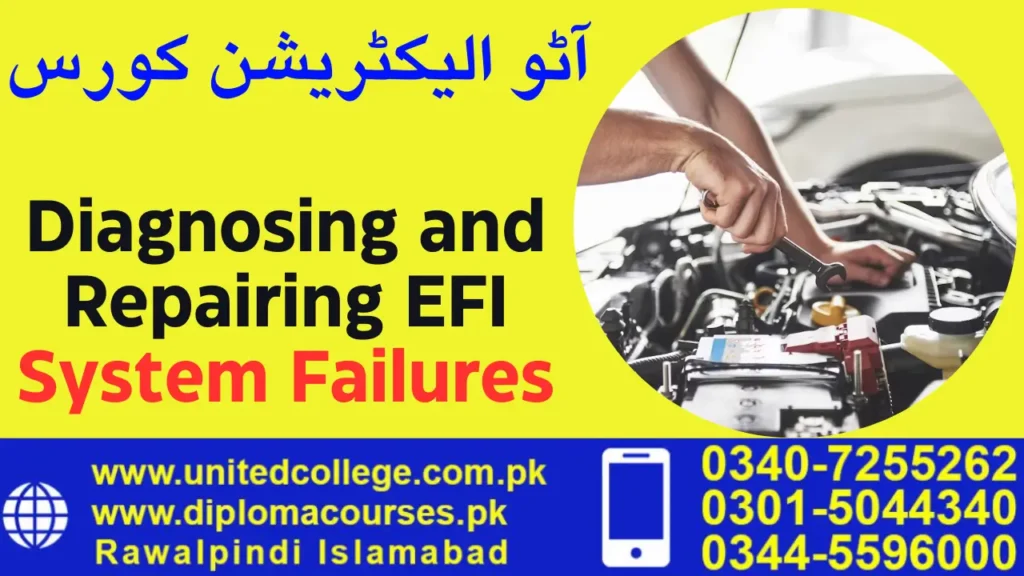Introduction to EFI (Electronic Fuel Injection
EFI (Electronic Fuel Injection) was the one to phase out carburetors and introduce a new way of delivering fuel. It is created in the form of a very detailed electronic system that replaced traditional carburetors. EFI auto electrician course attains this fuel-air mixture tight control, improving the engines’ horsepower, mileage, and emission levels. EFI auto electrician does this by employing sensors to continuously monitor various engine parameters, these include the ratio of air to fuel, duration of combustion time, cylinder pressure, and other parameters which help to achieve efficient combustion under varying conditions.
This technology has been widely spread in current vehicles that often give a seamless feel, start faster, and consume less fuel for maintenance. The knowledge on EFI auto electrician course basics is the key point for everyone engaged in automotive engineering or passionate car owners who aim to fully use their vehicles to the maximum level. Let us investigate how to become owners of an enhanced driving experience by using EFI.
History and evolution of EFI systems
The EFI auto electrician course bring great innovations to automotive engines by aiming for precise and multiple delivery of fuel for efficiency and performance. Beginning in the 1950s, the most primitive showings of EFI auto electrician course were in military aircraft and slowly moved into consumer vehicles in the 1970s. The 1980s was the period of wide assimilation of the technology in the mass-produced vehicles. New features like multi-point fuel injection that are more precise than the earlier versions were introduced in the mainstream cars.
With the advancements in technology, EFI sequential systems were introduced which eventually improved fuel delivery. The introduction of direct injection in the 21st century not only improves power and fuel efficiency. SEO optimization allows this history to be found by use of keywords such as “EFI evolution” or “fuel injection” to catch the attention of the enthusiasts and teach beginners something new.
Advantages of using EFI over carburetors
The EFI auto electrician course produces a series of benefits that Carburetor has no matching to it. Moreover, EFI auto electrician course systems achieve exact fuel injection, which leads to an enhanced air-fuel mixture to have a better combustion process and hence to a reduced pollutants emission.
Secondly, EFI auto electrician course achieves better starting over cold engine conditions and a smoother engine operation at various conditions due to the fact that besides fuel delivery it is capable of adjusting fuel delivery in a real-time. Not only this, the EFI auto electrician course provide more variety in engine tuning and bespoke performance, fitting to a wide variety of driving styles. Along with this, the electronic fuel injection system does not require the carburetors to be adjusted that often, and hence the smooth running of the engine over time is ensured.
Components of an EFI auto electrician course
An EFI auto electrician course consists of several fundamental parts of fuel delivery to internal combustion engines. The fuel injectors control fuel flow which is regulated by the Engine Control Unit (ECU). It is the fuel pump that is responsible for adequate pressure of supply, whereas, the throttle body is responsible for regulating the air intake.
The O2 sensor is used in this regard to measure oxygen levels of exhaust gases which in turn allows for fuel mixture adjustments. The intake manifold disperses the air-fuel mixture to cylinders while the fuel pressure regulator ensures proper pressure level. When they are put together, these elements will usually lead to an efficient engine, good fuel consumption, and clean emissions in modern vehicles.
Types of EFI auto electrician course
Throttle Body Injection (TBI): Features a single or dual injector setup mounted in the throttle body. Simplified and cost-effective, commonly found in older vehicles.
Multiport Fuel Injection (MPI): Utilises individual injectors for each cylinder, offering precise fuel delivery. Enhances performance and fuel efficiency, commonly seen in modern vehicles.
Direct Injection (DI): Sprays fuel directly into the combustion chamber, optimizing fuel combustion and engine efficiency. Promotes power and efficiency in newer vehicles.
Sequential Fuel Injection (SFI): Synchronises injector firing with the engine’s firing order, maximising fuel delivery accuracy and performance. Typical in advanced engine management systems.
Common troubleshooting and maintenance tips
- Restart devices regularly to clear temporary glitches.
- Update software and drivers to ensure compatibility and security.
- Check connections for loose cables or faulty ports.
- Run antivirus scans to detect and remove malware.
- Clear caches and cookies to improve device performance.
- Monitor system resources like CPU and memory usage.
- Backup important data regularly to prevent loss.
- Use diagnostic tools to identify hardware issues.
- Clean hardware components like keyboards and fans to prevent overheating.
- Refer to user manuals or online forums for specific troubleshooting steps.
Fundamentals of Auto Electrical Systems

Electricity operates based on fundamental principles, primarily involving the behaviour of charged particles. These principles include:
Basic principles of electricity
Electric Charge: Atoms consist of charged particles: positively charged protons and negatively charged electrons. When there is an imbalance of these charges, electricity occurs.
Voltage: Voltage, measured in volts (V), represents the electrical potential difference between two points in a circuit. It drives the flow of electric current.
Current: Electric current, measured in amperes (A), is the flow of electric charge carriers (usually electrons) through a conductor. It moves from areas of high voltage to low voltage.
Resistance: Resistance, measured in ohms (Ω), impedes the flow of current in a circuit. Materials with high resistance restrict current flow, while conductors have low resistance.
Ohm’s Law: Ohm’s Law states that the current flowing through a conductor is directly proportional to the voltage across it and inversely proportional to its resistance:
Understanding electrical circuits and wiring diagrams
The ability to use on the fundamentals of electricity concerns wiring diagrams and circuits is specially important to the techno territories like engineering and house situated repairs. A circuit may be considered as a collection of components used as a medium for electricity flow in a controlled manner. The basic concept of circuit relies on the combination of power source, conductive path, load, and the mechanical switch, which serves to control the motion of electrons. Circuit diagrams schematically show the circuits, depicting the mutual connections/relationships between components using standard symbols.
They offer a set of instructions which help build, debug, and maintain electrical systems. Learning circuit principles also encompasses acquiring knowledge on Ohm’s law, Kirchhoff’s laws and capacitors, resistors and inductors properties. More so, safety rules are vital since improper handling of electricity may bring about hazards as well. Knowledge of electric circuits and reading of wiring diagrams helps people control and rewire the electricity in a safe way, whether it’s for an advanced industrial system or a simple problem around the house.
Types of batteries and their functions
Alkaline Batteries: Commonly used in household devices like remote controls, they provide a reliable power source for low-drain devices.
Lithium-ion Batteries: Found in smartphones, laptops, and electric vehicles, these rechargeable batteries offer high energy density, making them ideal for portable electronics.
Lead-Acid Batteries: Utilised in vehicles and uninterruptible power supplies (UPS), they provide a robust power source with high surge currents.
Nickel-Cadmium (NiCd) Batteries: Known for their durability and resistance to overcharging, they’re often used in power tools and emergency lighting systems.
Nickel-Metal Hydride (NiMH) Batteries: Similar to NiCd batteries but with higher energy density, they’re commonly used in digital cameras and handheld gaming devices.
Lithium Polymer (LiPo) Batteries: Used in drones, RC vehicles, and wearables, they offer flexibility in shape and size due to their pouch-like structure.
Each type serves specific functions, catering to diverse power requirements across industries.
Alternator and starter motor operation
The alternator and starter motor are central components that a vehicle can function with. The alternator is responsible for generating the electrical power that is stored in the battery and supplying electricity to the different components when the engine is working. It is electromagnetic induction based that causes a rotating magnetic field to create an alternating current in the stator windings. As a result, the AC current begins to flow in a certain direction and then converted to DC by diodes which is then used by the vehicles electrical system.
On the other hand, the starter motor is responsible for initiating the engine’s combustion process by turning the crankshaft until the engine fires up. It operates by drawing electrical power from the battery to spin the engine’s flywheel, which in turn rotates the crankshaft. Once the engine starts, the starter disengages to prevent damage. Both the alternator and starter motor are vital components, ensuring the efficient functioning and starting of a vehicle.
Diagnosing and fixing common electrical issues
Solving the complex problems of electrical areas requires a system approach and compliance with safety regulations. Begin by identifying the problem: flickering light or a dead outlet, over or under-sized wire could be the reasons. To begin with, before you get your hands dirty inspect the wiring for any blatant signs of deterioration, notice wires that appear to be frayed or outlets that seem burnt. Then, utilise a voltage tester to make sure the circuit is dead before starting the repair. It could be any of the flickering lights which may be a loose bulb or connection but, if it is the case that all the outlets are dead, it might be a tripped GFCI or a faulty outlet.
Often the solution is simply to rest the GFCI or to replace the outlet. A breaker which keeps on tripping suggests that the circuit is overloaded or shortened; sometimes shifting those appliances or replacing the breaker is the only solution. Nevertheless, in the case of troubleshooting not resolving the problem, it is imperative to seek qualified assistance since mishandling of electricity may lead to electrocution or fire. Put safety first whenever dealing with electricity because there can be very dangerous consequences.
Diagnosing and Repairing EFI System Failures

Identifying common EFI system failures
Common EFI auto electrician system faults are faulty fuel injectors that cause misfires, the mass airflow sensor malfunction which leads to poor fuel economy, bad oxygen sensor that causes emissions, and the working faulty fuel pump which ends in the vehicle stalling. In functions like damaged leads or worn out connections which operations can also be a cause for EFI auto electrician course failure.
Using diagnostic tools and equipment
Employing diagnostic methods and gadgets is an inevitable factor due to the need in finding the areas to be repaired. It is mainly industrial, medical or technological applications that require these tools for getting powerful information to manage any task well. Using basic tools such as multimeters and oscilloscopes, to advanced machines such as MRI and tomography computed scanners, these devices precisely read and detect data, measure parameters, and find out what is causing the anomalies.
They provide professional information and accurate decisions which, in turn, help them provide solutions that assure the best performance and safety. In areas such as engineering, medicine or anything beyond, proficiency in diagnostic apparatuses enable efficiency, cut back on downtime and create innovations.
Conducting voltage drop tests
Voltage drops test should be done as a part of circuits’ integrity evaluation. This method lets one see the voltage difference involved in connections or components, and if this is exceeding the normal level, then it means there are probably breakdowns or inefficiencies. The function of reliable electrical systems is to guarantee safety and efficient performance. For that, they are intended to be tested constantly and precisely.
Repairing or replacing faulty components
When you need to make a decision between fixing old parts or buying new ones to avoid a similar problem again, then keep in mind the cost of repair versus replacement in relation to your budget. Evaluate these things: an age, an option of spare parts, an amount of money for the repair. Sometimes, repairing is not a durable solution, unlike replacing since it is advantageous in the long run. Various solutions are available to fix the problem. Apply the most suitable one which does not lead to additional difficulties.
Resetting the engine control unit (ECU
The EVAP (Evaporative Emission Control) system helps in regulating the emission of evaporative hydrocarbons from the fuel tank. A particular step usually is to separate the battery by disconnecting it for a few mins. The aim is to rectify some problems as for example with sensors or after performing maintenance operations or modifications, thus leading to the engine operating better and with higher efficiency levels.
Tuning and Calibrating EFI Systems
The air/fuel ratio is the proportion of air to fuel in an internal combustion engine. Stoichiometrically, it’s around 14.7:1 for gasoline engines. Ignition timing determines when the spark plug fires to ignite this mixture. Proper synchronisation of air/fuel ratio and ignition timing optimizes engine performance, efficiency, and emissions.
Methods for adjusting EFI systems
- Using a tuner tool to modify fuel maps and ignition timing.
- Installing larger injectors for increased fuel delivery.
- Adjusting the air-fuel mixture via the throttle body or airflow sensor.
- Upgrading to a performance-oriented ECM (Engine Control Module).
Dynamic vs static tuning
Dynamic tuning adjusts parameters in real-time based on system conditions, ensuring optimal performance in varying scenarios. It adapts to workload changes, enhancing efficiency and responsiveness. Conversely, static tuning involves setting parameters manually, suitable for stable environments but less adaptable to fluctuations. Dynamic tuning enables agility and scalability, crucial in dynamic computing environments.
Fine-tuning for optimal performance
Fine-tuning for optimal performance involves meticulous adjustments to maximize efficiency and effectiveness. Through iterative refinement and calibration, systems, processes, or skills can achieve peak functionality. This continuous optimization ensures optimal outcomes, harnessing the full potential of resources and capabilities for superior results.
Best practices for tuning different types of engines
Tuning engines demands precision and expertise. For gasoline engines, adjust air-fuel ratios, ignition timing, and optimize intake/exhaust systems. With diesel engines, focus on fuel injection timing and pressure. For electric motors, fine-tune controller settings and monitor battery health. Prioritise safety and consult manufacturer guidelines for optimal performance.
Installing and Upgrading EFI Systems

Steps for installing a new EFI system
- Gather necessary tools: EFI system kit, wrenches, screwdrivers.
- Disconnect battery to avoid electrical mishaps.
- Remove old carburetor, intake manifold, and associated components.
- Install EFI throttle body, fuel injectors, and sensors on the intake manifold.
- Connect the wiring harness and fuel lines.
- Reconnect battery and test system.
Choosing the right system for your vehicle
Selecting the ideal system for your vehicle demands thorough consideration. Assess your driving habits, terrain, and climate. For off-road adventures, prioritise ruggedness and traction. Urban commuters may favour fuel efficiency and smooth handling. Whether it’s all-wheel drive, front-wheel drive, or rear-wheel drive, tailor your choice to suit your lifestyle and needs
Advantages of upgrading from a carburetor to EFI
Upgrading from a carburetor to EFI auto electrician course offers numerous advantages. EFI improves fuel efficiency, enhances engine performance, and ensures smoother cold starts. It provides precise fuel delivery, resulting in better throttle response and reduced emissions. Additionally, EFI auto electrician course systems offer easier diagnostics and tuning capabilities.
Customizing an EFI system for specific performance goals
Customizing an EFI auto electrician course involves tailoring fuel delivery, ignition timing, and other parameters to meet specific performance goals. By adjusting parameters like air-fuel ratio and injector timing, EFI auto electrician course can optimize engine performance for power, efficiency, or any other desired outcome, enhancing overall vehicle performance.
Safety considerations for installing and upgrading EFI systems
- Disconnect the battery to avoid electrical hazards.
- Follow the manufacturer’s instructions meticulously.
- Ensure proper grounding to prevent electrical issues.
- Handle fuel components cautiously to prevent fire hazards.
- Double-check connections to prevent malfunction or damage.
Advanced EFI auto electrician course Troubleshooting

Advanced diagnostic techniques
Advanced diagnostic techniques employ cutting-edge technology to identify illnesses or conditions with precision. These methods include molecular imaging, genetic testing, proteomics, and advanced medical imaging like MRI, CT scans, and PET scans. By integrating these techniques, healthcare providers can offer more accurate diagnoses, leading to tailored treatment plans and improved patient outcomes.
Identifying and addressing complex failures
Identifying and addressing complex failures demands a multifaceted approach. It involves thorough analysis, clear communication, and collaborative problem-solving. By fostering a culture of transparency and accountability, organisations can effectively diagnose root causes and implement sustainable solutions, preventing recurrence and promoting continuous improvement.
Identifying and addressing complex failures
Understanding error codes and ECU programming is crucial for vehicle diagnostics and maintenance. Error codes provide insights into malfunctions, while ECU programming allows customization and optimization of vehicle performance. Familiarity with these concepts ensures efficient troubleshooting and enhances the overall functionality and reliability of automobiles.
Troubleshooting specialized systems like turbochargers and forced induction
Troubleshooting turbochargers and forced induction systems requires meticulous attention to detail. Start by checking for boost leaks, inspecting hoses and connections, and testing the wastegate functionality. Monitor boost pressure, exhaust temperature, and listen for abnormal sounds. Diagnostic tools like boost gauges and OBD scanners can aid in pinpointing issues accurately.
Tips for preventing future failures
Learn from past mistakes: Reflect on failures for valuable insights.
Plan meticulously: Anticipate potential obstacles and devise strategies to mitigate risks.
Embrace adaptability: Be ready to pivot when circumstances change.
Prioritise communication: Clear and open dialogue fosters collaboration and problem-solving.
Cultivate resilience: Bounce back stronger from setbacks with determination and positivity.
EFI System Maintenance and Service

Regular maintenance tasks for EFI systems
Regular maintenance tasks for EFI auto electrician course include checking and cleaning fuel injectors, inspecting and replacing air filters, monitoring fuel pressure and throttle body cleanliness, scanning for error codes, and updating software. These tasks ensure optimal engine performance, fuel efficiency, and longevity of the EFI auto electrician course.
Changing fuel filters and cleaning injectors
Regular maintenance like changing fuel filters and cleaning injectors is vital for optimal engine performance. Fuel filters prevent contaminants from reaching the engine, while clean injectors ensure proper fuel atomization and combustion. Neglecting these tasks can lead to reduced fuel efficiency, engine misfires, and ultimately, costly repairs.
Servicing the ECU and other components
Servicing the ECU and other components is vital for optimal vehicle performance. Regular maintenance ensures smooth operation, enhances fuel efficiency, and prolongs the lifespan of essential systems. From updating software to checking connections, diligent care keeps your car running reliably, ready for the road ahead
Best practices for storing and winterizing your vehicle
To preserve your vehicle during winter, follow these tips: Clean thoroughly to prevent rust, top up fluids to avoid freezing, inflate tires to recommended pressure, use a fuel stabiliser, store in a dry, sheltered area, disconnect the battery or use a trickle charger, and consider using a car cover for extra protection.
Maintenance schedules for high-performance engines
Maintenance schedules for high-performance engines are critical for ensuring optimal performance and longevity. Regular checks on fluid levels, filters, belts, and ignition systems are imperative. Scheduled inspections help prevent costly breakdowns and ensure peak efficiency. Adhering to these schedules preserves the engine’s power and reliability under demanding conditions.
Safety Protocols for Working with Auto Electric Systems

Understanding electrical safety risks
Understanding electrical safety risks is paramount in preventing accidents. From faulty wiring to improper equipment use, negligence can lead to severe consequences like electric shocks, fires, or even fatalities. Awareness of potential hazards, proper training, and adherence to safety protocols are essential in safeguarding lives and property.
Using personal protective equipment (PPE)
Using personal protective equipment (PPE) is essential for safeguarding against workplace hazards. From gloves and goggles to masks and helmets, PPE shields workers from injuries and illnesses. Proper selection, fitting, and maintenance of PPE ensure its effectiveness, promoting a safe and secure work environment for all.
Proper handling and disposal of hazardous materials
Proper handling and disposal of hazardous materials is vital for environmental and human health. Adherence to safety protocols prevents contamination and harm. Utilise designated containers, protective gear, and follow disposal guidelines to mitigate risks. Responsible actions safeguard ecosystems and communities from potential harm posed by hazardous substances
Safety guidelines for working with high-voltage systems
When working with high-voltage systems, prioritise safety above all. Adhere to strict protocols: wear insulated gear, maintain proper distance, and never work alone. Regularly inspect equipment for damage, and ensure all team members are well-trained in emergency procedures. Vigilance saves lives in the face of electrifying risks.
Emergency procedures in case of accidents
In case of accidents, follow emergency procedures promptly. Assess the situation calmly, prioritise safety, and seek medical assistance if necessary. Notify authorities immediately and provide clear, concise information about the incident. Follow designated protocols to ensure the well-being of everyone involved and minimise further risks.
Career Opportunities in Auto Electrics

Types of jobs in the auto electric industry
In the auto electric industry, jobs range from automotive electricians who diagnose and repair electrical systems to automotive engineers designing cutting-edge electric vehicles. Technicians specialise in installing and maintaining electric components, while researchers explore advancements in battery technology. Sales and marketing professionals promote electric vehicles and related products to consumers and businesses.
Education and training requirements
Education and training requirements vary widely across professions, ranging from formal degrees to on-the-job training. While some careers demand advanced degrees, others prioritise practical experience. Ongoing learning is often essential due to evolving technologies and industry standards, emphasising the need for continuous professional development to stay competitive in the workforce.
Skills and qualities needed for success
Success demands a blend of skills and qualities. Among them, resilience navigates setbacks, determination fuels persistence, adaptability embraces change, and creativity sparks innovation. Effective communication fosters collaboration, while leadership inspires and guides. Continuous learning fuels growth, while humility keeps egos in check. Together, they pave the path to achievement.
Employment outlook and salary expectations
The employment outlook and salary expectations vary across industries and regions. While some sectors may experience growth, others face challenges. Researching market trends and acquiring relevant skills can enhance prospects. Additionally, being adaptable and open to negotiation can help attain satisfactory salary packages aligned with experience and qualifications.
Advancement opportunities in the field
In the ever-evolving landscape of [insert field], advancement opportunities abound, offering avenues for growth and fulfilment. From mentorship programs to specialised training, professionals can ascend through the ranks, gaining expertise and responsibility. Embrace challenges, seek learning, and seize opportunities to carve a path toward success in your chosen domain.
Future Developments in EFI Technology

Emerging trends in the auto industry
Emerging trends in the auto industry showcase a shift towards electric and autonomous vehicles, driven by environmental concerns and technological advancements. Connectivity features, such as advanced infotainment systems and vehicle-to-everything communication, are becoming standard. Additionally, there’s a growing focus on shared mobility and subscription-based services to cater to changing consumer preferences
Latest advancements in EFI auto electrician course
Recent advancements in EFI auto electrician course have revolutionised engine performance. Innovations like direct injection, variable valve timing, and sophisticated engine management algorithms optimize fuel delivery and combustion, resulting in improved power output, fuel efficiency, and reduced emissions. These advancements mark a significant leap in automotive engineering.
Potential impact of new technology on the industry
The integration of advanced technology into industries promises transformative changes, enhancing efficiency, and reshaping workflows. Automation can streamline processes, reducing costs and time, while artificial intelligence offers insights for strategic decision-making. Embracing these innovations fosters competitiveness and unlocks untapped potential, propelling industries into new frontiers of growth and innovation.
Predictions for the future of EFI auto electrician course
In the future of auto electrics, we anticipate a surge in electric vehicle adoption, with advancements in battery technology extending range and reducing charging times. Integrating AI-driven systems for autonomous driving and smart energy management will become commonplace, revolutionising transportation for efficiency, safety, and sustainability.
Opportunities for professionals to stay up-to-date with advancements
Professionals can leverage various avenues to stay abreast of advancements. Engaging in continuous learning through online courses, attending industry conferences, joining professional networks, and subscribing to relevant publications are effective strategies. Embracing these opportunities ensures professionals remain informed and equipped to excel in their respective fields.

